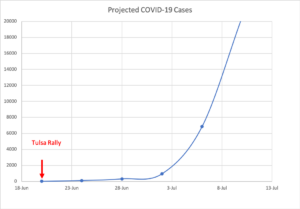Science of Covid19 is happening at a pace and in a way that I have never experienced before. Papers are released, dissected, and discussed by thousands of readers before they are even peer-reviewed. By the time they are actually published, perhaps a week later, they are old news in the research community. The result of this is a flood of conflicting findings based on a trickle of incomplete data that unleashes debates with major implications.
This past Friday saw a group of five papers released, which considered the spread of the virus and their conclusions left me reeling. Three manuscripts seem to confirm our current beliefs and two turn them on their head with the suggestion that the virus has spread far more explosively and infected as many as 200 times more people than we thought. A closer look at these papers is informative in terms of what we know, what we don’t know, and the nature of the scientific process in these trying times.
On the one hand, we have papers from two teams attempting to model the spread of the disease mathematically. One concludes, based on data from China, that there may be as many as 200 cases of mild, asymptomatic, or otherwise undetected cases for every one case identified by testing, suggesting that asymptomatic or mild infections dwarf the those with serious symptoms and immunity is far more widespread than we imagine. The second concludes, based on a purely mathematical model, that the reproductive number (R0) (the average number of people infected by each new case) is between 6 and 27, rather than the 2 to 3 previous research has suggested.
At the same time, three other papers, one a disease modeling study and the other two relying on old school epidemiology to look at rates of infection in household contacts of known cases, present an opposite version of events that hews more closely to conclusions drawn in prior studies. A team at Notre Dame developed a mathematical model that accurately predicted the spread of Covid19 based on an R0 of 1.98 and the assumption that 80% of infections go undetected. That’s still many undetected cases, but nowhere near 200. Two studies from China, one in Guangzhou and one in Shenzhen, followed household contacts of known cases and found that 10-15% of household members became infected. Hardly explosive growth.
I saw the two mathematical models first and thought my head might explode, since they seemed to contradict everything we have been assuming about the disease. I do believe that the disease is likely to be more contagious than we think because there are many undetected cases out there, but the numbers in these papers were staggering. They would mean, for example that, instead of 150,000 cases in the US today, there are 30 million. That number, if correct, would change everything we know and call for a complete change in our control measures. But models are only as good as their assumptions and models that contradict reality are making bad assumptions.
There is no way that a virus with an R0 of 27 (or even 6) would only infect 15% of household contacts. It also seems unlikely that a disease with the potential to be as deadly as Covid19 is resulting in more than 29 million cases that are so mild we don’t even know they are happening.
Buried in these papers is a desperate cry for more data and a warning about the pitfalls of mathematical modeling. We have no way of accurately assessing the spread and prevalence of this disease until we get an accurate count of cases. That will require a cheap, rapid test to determine who has been infected. Such tests are in the works, but until we have data from a general population sample, all mathematical models are pure speculation and should be interpreted with extreme caution.


